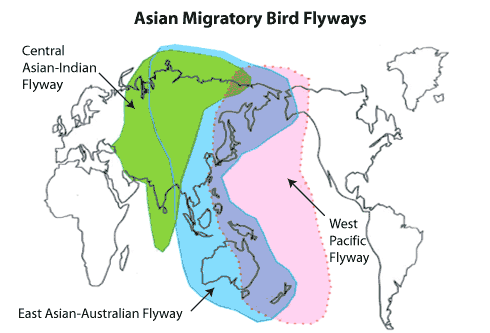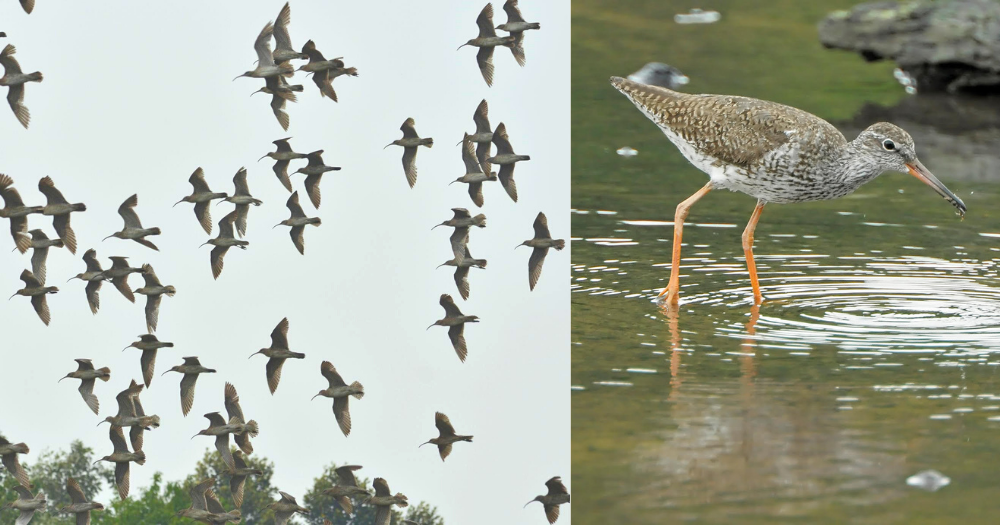We might not be able to fly to travel for leisure this year, but one group of animals are still taking flight: birds.
Birds in temperate regions often migrate to escape winter to enjoy tropical holidays in warmer parts of the world, such as countries near the equator.
Migratory birds travel a long way to come to Singapore
While humans can just hop on planes to travel from one country to another, birds use "highways in the skies", which are known as flyways.
One flyway migratory shorebirds use to get to Singapore during winter is the East Asian-Australasian Flyway, which is the world's largest migratory route.
This flyway stretches from Arctic Circle in the Northern Hemisphere to Australia and New Zealand in the Southern Hemisphere (as indicated by the animated red dotted line below):
 GIF via haribon.org.ph
GIF via haribon.org.ph
The East Asian-Australasian Flyway is an easier route as compared to the Central Asian Flyway as it offers the option of flying along coastal routes where birds can land to eat and replenish their energy.
The Central Asian Flyway is a more treacherous route for birds as they will have to fly directly across the Himalayas where the oxygen level is low and the weather is bitter cold.
Despite the difficulties, some birds might choose to take this route to reduce flying time to get to their breeding grounds.
Previously, Singapore was thought to be along only the East Asian-Australasian Flyway, but a new study found that birds travelling along the Central Asian Flyway also come to Singapore to rest and refuel.
Singapore is possibly an intersection of two major flyways
A study published in Nature's Scientific Reports on Dec. 11 showed that some shorebirds that come to Singapore via the Central Asian Flyway.
This is also the first time that shorebird migration routes across the Himalayas from Southeast Asia have been documented.
 Graphic of Asian Migratory Bird Flyways by the US federal government, Fish and Wildlife Service
Graphic of Asian Migratory Bird Flyways by the US federal government, Fish and Wildlife Service
For the study between 2014 to 2019, 15 birds from two species of birds, common redshanks and whimbrels, had tiny satellite tags and geolocators attached to a part of their left leg.
Using these tracking devices, researchers found that these small shorebirds make their way across the towering Himalayas to get to their breeding grounds up north in China and Russia after spending time at our wetlands such as the Sungei Buloh Wetland Reserve.
This means that Singapore could be at the intersection between the two major flyways that cut through Asia.
The new findings gave us more reasons to conserve our wetlands and mudflats so that Singapore can continue to support the survival of these migratory birds, Minister for National Development Desmond Lee said.
While Singapore has forged partnerships along the East Asian-Australasian Flyway, the above-mentioned study shows that partnerships need to be established along the Central Asian Flyway as well.Migratory birds losing pitstops to refuel
According to WWF, human development has added challenges to bird migration.
While making their trips across the globe, birds often stop-over at different habitats along the way, such as wetlands.
However, these pitstops, such as coastal wetlands, or even breeding grounds are being developed for various agricultural, urban and industrial uses.
This can negatively impact the success of the migration of birds along flyways, as they are unable to refuel along their long and arduous journeys.
WWF reported that over 60 per cent of the waterbird populations in Asia are on the decline or have gone extinct in the past 20 years.
This is where conservation initiatives have a role to play as partnerships with various organisations in countries along the flyway can help to help to reduce or stop the decline of the migratory birds.
You can learn more about the challenges that birds face during migration in this video:
Totally unrelated but follow and listen to our podcast here
Top photos via Desmond Lee/FB
If you like what you read, follow us on Facebook, Instagram, Twitter and Telegram to get the latest updates.
